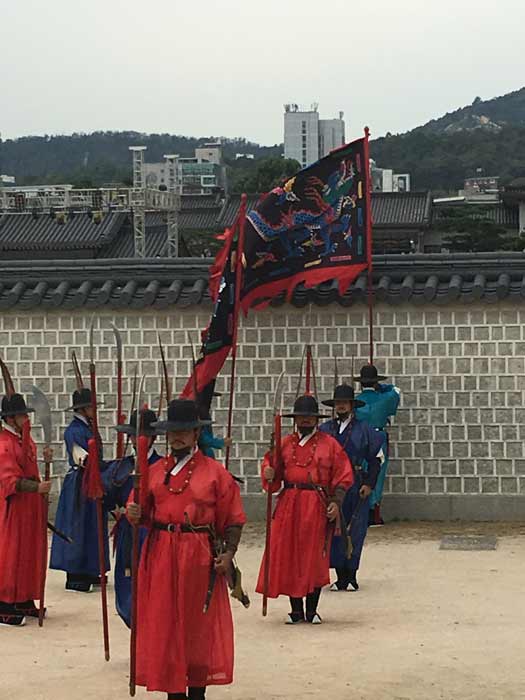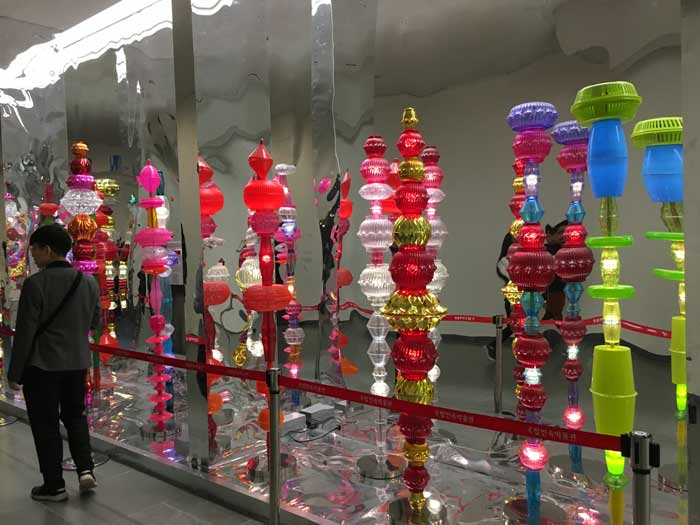We began the day at the Gwanghwamun Gate, which is the main gate to the Gyeongbukgung Palace. (Note there are several palaces in Seoul).

Gyeongbukgung Palace Entrance
Luckily, we arrived just as the changing of the guard was taking place.

Changing of the Guard

Changing of the Guard

Changing of the Guard

Changing of the Guard

Changing of the Guard

Changing of the Guard
The National Folk Museum is located nearby.

National Folk Museum of Korea
Next to the entrance is a recreation of a traditional Korean village of times past. A number of barrels for kimchi making are displayed along with the straw huts the barrels where put into while the kimchi was fermenting. If you are not familiar with kimchi, it’s cabbage fermented with salt and a variety of seasonings including chili powder, scallions, garlic, and ginger. It was not my favorite.

Kimchi vessels
My favorite exhibit at the Folk Museum was right there when you walked through the entrance–a lily which opened and closed. You can see how large it is in comparison to the people standing behind it.

Lily fully open

Lily mid-open

Lily partially open or closed, depending on how you see it

Lily closed
I enjoyed the beauty of this sparkling aluminum and glass wall.

Glass Wall
Also on display are the White Tiger and Asiatic Black Bear, the mascots for the 2018 Olympics coming up soon. Our tour organizer Lissa is lucky enough to have tickets to two speed skating events.

2018 Olympic Mascots
Next up was a stroll through Bukchon, known for its shops, restaurants, and art galleries. This is a hill popular among visitors for its beautiful, traditional Korean homes. It’s so popular many houses have signs on the front explaining “this is a private home, “or “please be quiet–people live here.”

Bukchon
This gallery had an exhibit of one of my favorite fiber/mixed media artists. Unfortunately, we didn’t have time for a quick stop, and I never had the opportunity to return.

Art gallery
While in Bukchon we viewed a Saeksilnubi exhibition, a fiber art that I was unfamiliar with. It is made by joining two layers of fabric with cotton or hanji (traditional Korean Mulberry paper) strings in between. The fabric is hand-stitched along each string, helping the item to keep its shape and stay durable. It is a difficult and intricate work requiring much concentration, years of self disciplined training, and exceptional talent, resulting in the marriage of practicality, beauty, and craftsmanship.

Saeksilsnubi

More Saeknilsubi

Head Decoration
Shortly after the Saeknilsubi exhibit, I happened upon a little girl wearing one of the flowers, and her parents let me take her picture.

Little Girl wearing a Saeksilnubi flower
Here was a display of traditional Korean pillows. They are cylindrical with broad, flat surfaces at each end and covered in intricate embroidery or patchwork. For centuries, Koreans believed that pillow decorations could influence the sleeper’s dreams and that auspicious ones could make wishes come true. In times past the pillows held a wooden form or small stones. Not very comfortable.

Bed Pillows
If all of this wasn’t enough, we had a Hanji workshop in the evening. I was tired when we arrived and wasn’t too keen when I learned the craft involved glue. There’s a reason I work in fiber. Me and glue don’t mix. It seems to stick to me and then everything I touch. But I was pleasantly surprised at how much fun it is to work with mulberry paper. It stretches a bit as you work with it, allowing you to fit it to your form. And as with fabric, I like the texture of this paper. We had a choice of covering a small mirror or a picture frame. The flowers on the back of the hand mirror are made by wetting and stretching the mulberry paper, creating the petals’ and leaves’ wispy edges.

Mirror made by a fellow participant

Mirror made by a fellow participant

Mirrors made by our instructor
Here’s a picture frame made by the instructor similar to what some of us made in the workshop.

Picture Frame featuring Hanji
Some examples of Hanji created by our instructor on view in her studio.

Cabinet

Cabinet


